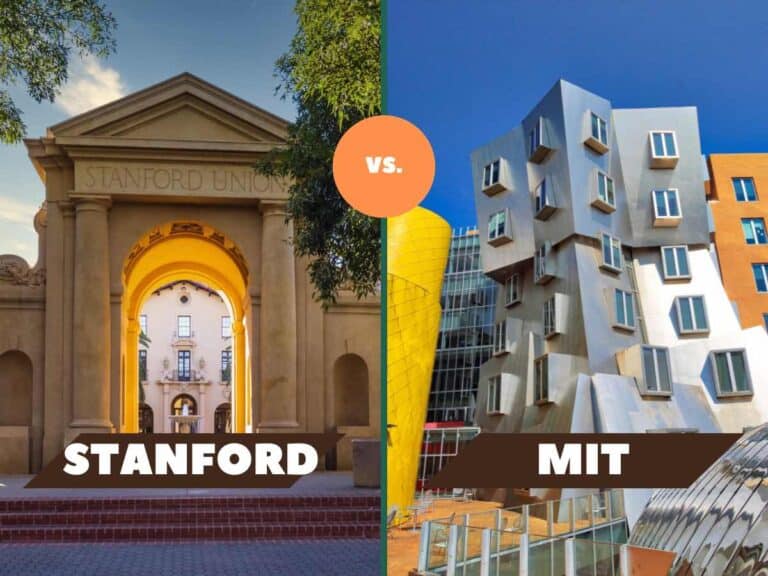MIT or Stanford: Which One Will Catapult Your Career?
Not all prestigious academic institutions in the United States are Ivy League schools.
Case in point: the Massachusetts Institute of Technology (MIT) and Stanford University, which are highly selective colleges considered Ivy Plus schools.
MIT is in Cambridge, MA, while Stanford is in Stanford, CA.
Their locations may be more than 3,100 miles away from each other, but MIT and Stanford have a lot of things in common, including their selectivity level and academic quality.
So, is MIT or Stanford better?
Whether MIT is better than Stanford or the other way around is on a case-to-case basis. It will depend on a soon-to-be undergraduate student’s preferences in terms of cost, campus life, academics, and career goal.
Both MIT and Stanford shine in undergraduate engineering programs.
Both are party schools, but MIT is a bigger party school with a more vibrant Greek life than Stanford, although both have an equally diverse, inclusive, and supportive campus.
This article is an MIT vs. Stanford post, and I will discuss some of the most important things you need to know about these elite institutions to help you make a more informed decision.

Acceptance Rates
Both MIT and Stanford are some of the most competitive postsecondary institutions in the US.
They’re equally selective that, as of this writing, they share the same acceptance rate: 4%. It means your chances of getting into either MIT or Stanford are alike.
But to have a better idea of which is more selective, we should consider the number of applicants per year.
Every year, MIT receives over 21,000 applications.
On the other hand, Stanford gets over 47,000 applications per year.
Based on these figures alone, it’s plain to see that you have better chances of receiving an acceptance rate from MIT — fewer students are competing to be one of the 4% successful candidates each admissions cycle.
But it’s also worth noting that both MIT and Stanford waitlist some applicants.
In this matter alone, you have better chances of ending up attending Stanford.
That’s because approximately 13% of waitlisted students at Stanford end up getting an offer to enroll, while 0% of waitlisted students at MIT wind up getting an offer to attend.

College Rankings
A couple of important things before anything else: you should not choose a college based on rankings alone, and your performance and grades matter more to most employers than a college’s reputation.
Still, a highly-ranked college may help catapult your career because of the following:
- Prestige
- Brand recognition
- Quality of education
- Resources
- Networking opportunities
Based on US News rankings alone, MIT is slightly better than Stanford.
As of this writing, US News ranks MIT #2 in National Universities, while it ranks #3 in National Universities — they are only a spot away from one another, but it can be a game changer for students torn between these two schools.
Global ranking-wise, MIT takes the cake, too.
US News ranks MIT #2 in Best Global Universities, while it ranks Stanford #3 in Best Global Universities.
QS, a popular and reputable ranker of academic institutions across the globe, shares the same sentiment as US News: it ranks MIT #1 in QS World University Rankings, while it ranks Stanford #5 in QS World University Rankings.
However, Times Higher Education (THE), another respected global college ranker, disagrees.
It ranks Stanford #2 in THE World University Rankings, while it ranks MIT #3 in THE World University Rankings.
With various college ranking sites having different opinions (though not that dissimilar) of the reputation of both MIT and Stanford, remember to consider whose methodology aligns more with your preferences.

Cost of Attendance
There is no use getting accepted to a prestigious university if your family cannot afford it for four years.
It’s due to this that the cost of attendance (COA) is an utmost consideration when deciding which institutions to include in your college list or which school you should commit to by National College Decision Day (May 1).
Between MIT and Stanford, the former is slightly easier on the savings.
Based on the most recent data from these elite institutions, tuition at MIT costs $61,990 (making up around 72% of the total COA), while tuition at Stanford costs $65,127 (making up approximately 70% of the total COA).
Here’s a breakdown of the estimated COA for both MIT and Stanford:
| Expenditures | Cost at MIT | Cost at Stanford |
|---|---|---|
| Tuition | $61,990 | $65,127 |
| Fee | $406 | $2,400 |
| Room and board | $20,280 | $21,315 |
| Books and supplies | $910 | $825 |
| Personal expenses | $2,374 | $3,225 |
| TOTAL | $85,960 | $92,892 |
However, it’s crucial to keep in mind that the above COA is the sticker price or price before aid.
Based on data from the BigFuture by the College Board, around 97% of first-time, first-year students at MIT with demonstrated need receive aid, each one getting an average amount of $60,077 per year.
On the other hand, about 99% of first-time, first-year students at Stanford with demonstrated need receive aid, each one getting an average amount of $66,562 per year.
Financial aid-wise, it’s apparent that Stanford, while more expensive than MIT, has better aid offers.

Popular Programs or Majors
When it comes to the academic programs for which they’re popular, MIT and Stanford have something in common: they have some of the most sought-after undergraduate engineering programs in the United States.
Given that MIT is a technological school, it isn’t surprising that it shines in STEM fields.
It’s in engineering that MIT is mostly known for.
Some of MIT’s most-highly ranked undergraduate engineering programs include:
- Aerospace
- Biomedical
- Chemical
- Civil
- Computer
- Electrical
- Environmental
- Mechanical
Needless to say, MIT is popular, too, in computer science.
MIT also attracts students interested in undergraduate business-related programs such as accounting, analytics, finance, entrepreneurship, management, and marketing.
As mentioned, Stanford also offers top-notch engineering programs.
Here are the most highly-ranked undergraduate engineering programs at Stanford:
- Aerospace
- Biomedical
- Chemical
- Civil
- Computer
- Electrical
- Environmental
- Industrial
- Materials
- Mechanical
Like MIT, Stanford is also known for computer science.
MIT offers 51 majors (computer science is the most popular), and it expects undergraduate students to declare and commit to a major by the end of their sophomore year of college.
Meanwhile, there are 115 majors available at Stanford (social sciences is the most popular), and undergraduates can declare a major during the first or second year — they must declare one during sophomore spring.

Campus Life
MIT has a slightly more diverse campus.
Around 64% of the Massachusetts Institute of Technology’s students are from minority or underrepresented groups, while roughly 62% of Stanford’s students come from the said groups.
Both MIT and Stanford have the same number of international students: about 11% of the entire population.
First-time, first-year students at MIT must reside on campus for one year — they can choose from 10 resident halls, each one having different cultures, traditions, and dining arrangements.
Stanford also requires freshmen students to reside in one of the 50+ undergraduate housing options for a year.
MIT and Stanford share another thing in common: they’re both big party schools.
However, based on rankings by Niche, it seems that MIT is a bigger party school — Niche ranks MIT #119 in Top Party Schools in America, while it ranks Stanford #253 in Top Party Schools in America.
At MIT, there are more than 450 student clubs and organizations, about one for every 10 undergraduates.
Meanwhile, undergraduate students at Stanford can choose from more than 700 official clubs and organizations.
When it comes to Greek life, there’s no doubt that MIT takes the cake!
There are 43 fraternity and sorority groups at MIT. Around 44% of male undergraduates and about 25% of female undergraduates at MIT are members of Greek-letter associations.
On the other hand, only four fraternities and seven sororities exist at Stanford. Approximately 16% of male undergraduates and 22% of female undergraduates at Stanford participate in Greek life.
Read Also:
- Stanford vs. Harvard
- Yale or Stanford
- Stanford vs. Caltech
- Colleges Similar to MIT and Stanford But Less Competitive
Disclaimer: The views and opinions expressed in this article are those of the authors and do not necessarily represent those of the College Reality Check.





